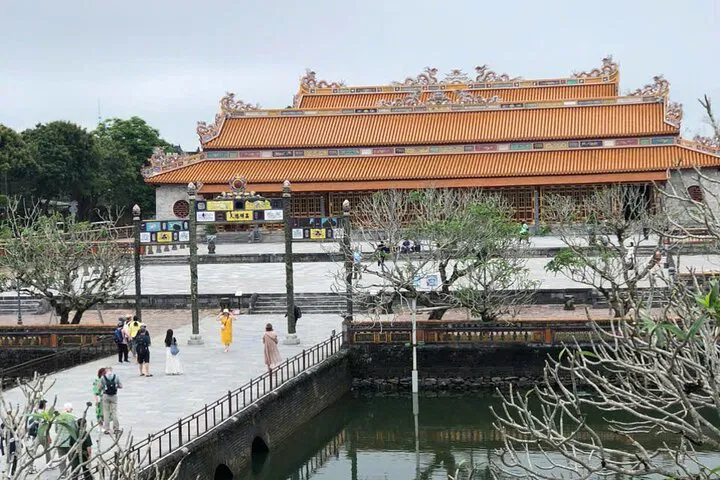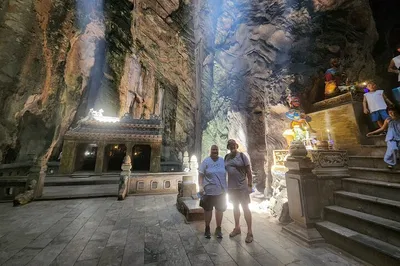Hue Imperial City Walking Tour | Max 12 People
150
Overview
The Hue Imperial City Walking Tour offers an immersive journey into Vietnam's royal past. This small-group tour, capped at 12 participants, provides an intimate exploration of the Imperial Citadel and Forbidden City during a 2.5-hour guided walk.
Visitors can expect to step back in time as a local guide shares insights into Hue's history and Vietnamese royal culture. Key stops include the Nine Dynastic Cannons (Cửu Vị Thần Công), the towering Flag Tower (Kỳ Đài), and the majestic Ngo Mon Gate. The tour continues through the Thai Hoa Palace (Palace of Supreme Harmony), past the Nine Dynastic Urns, and into the Thế Miếu Temple. Guests will also discover the secrets of the Purple Forbidden City, marvel at the Kien Trung Palace, and stroll along the Truong Lang (Long Corridor). The tour concludes with visits to the serene Hall of Peace (Thai Binh Lau), the Royal Theatre, and the Hien Nhon Gate.
Included in the tour is an English-speaking guide who can explain all of the rich history of the Imperial City, but it excludes all fees and taxes, private transportation, and bottled water. This walking tour provides a deep dive into the heart of Vietnamese royalty.
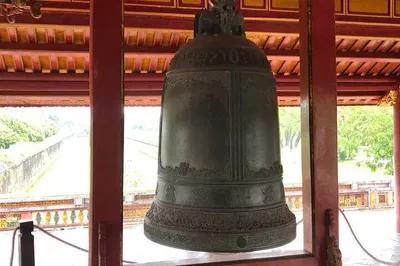
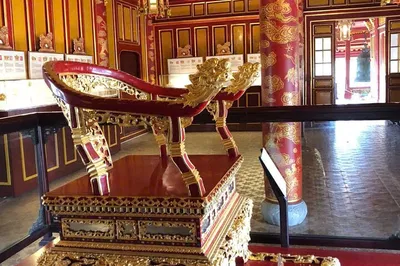
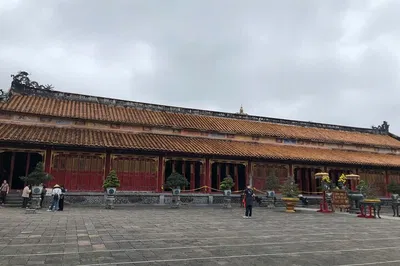

Highlights
Small Group Experience: Enjoy a more personalized tour with a maximum of 12 participants.
Expert Local Guide: Gain valuable insights into Hue's history and culture from a knowledgeable English-speaking guide.
Iconic Landmarks: Visit key historical sites like the Forbidden City, Thai Hoa Palace, and Nine Dynastic Urns.
Immersive Cultural Experience: Step back in time and explore the intricate nuances of Vietnamese royal life.
Sentiment Analysis
Customers generally enjoyed the tour of Hue Imperial City. They liked the guide's knowledge and the historical sights. Some didn't like the extra fees or the lack of provided water.

People really liked their tour guide.
They thought the guide knew a lot about the city.
Customers enjoyed walking around the old city and learning about history.
Visitors mentioned that even though it was hot, the tour was still great.
Some people did not like having to pay extra fees.
A few visitors wished they had water.
The Journey
Nine Dynastic Cannons (Cửu Vị Thần Công)
Witness the formidable Nine Dynastic Cannons, symbols of Vietnamese military prowess and artistry cast in 1803-1804 during Emperor Gia Long's reign. More than weapons, these bronze masterpieces showcase intricate carvings and exceptional bronze-casting techniques, representing a pinnacle of 19th-century Vietnamese art. Marvel at their imposing presence and appreciate the historical significance they hold as guardians of the Imperial City.
Flag Tower (Kỳ Đài)
Stand at the foot of the Flag Tower (Kỳ Đài), a historic sentinel that has witnessed pivotal moments in Nguyen Dynasty history. Once the stage for royal festivals, celebrations, and important public announcements, this iconic tower offers a glimpse into the vibrant imperial life of Hue and the customs of the Nguyen Dynasty. Climb to its summit for panoramic views of the Citadel and imagine the grand ceremonies that once unfolded below.
Ngo Mon Gate
Pass through the majestic Ngo Mon Gate, the main entrance to the Imperial City, once exclusively reserved for the emperor and his royal entourage. Admire its unique five-phoenix design and resilient architecture, which has withstood the ravages of time and war. As a symbol of Hue's imperial past, the Ngo Mon Gate serves as a grand portal to a bygone era, inviting you to step into the world of emperors and empresses.
Thai Hoa Palace (Palace of Supreme Harmony)
Enter the Thai Hoa Palace, the Palace of Supreme Harmony, the most important palace within the Imperial City and the venue for the most significant imperial ceremonies. Stand in the presence of the emperor's throne and imagine the grandeur of royal events that once unfolded within these walls. As a key symbol of the Nguyen Dynasty's royal authority, the Thai Hoa Palace offers a profound connection to Vietnam's imperial past.
Nine Dynastic Urns
Behold the monumental Nine Dynastic Urns, colossal bronze structures crafted between 1835 and 1837 under Emperor Minh Mang. Each urn, standing at 2.3 meters tall and weighing up to 2.6 tons, is adorned with intricate images that reflect the cosmic worldview and human beliefs of the era. These urns are not just artistic masterpieces but also powerful symbols of the Nguyen Dynasty's power and longevity.
Thế Miếu Temple
Visit Thế Miếu Temple, a sacred place of worship dedicated to the Nguyen emperors and their queens, as well as the esteemed officials who contributed to the Nguyen Lords' reign. Discover the ancestral tablets and learn about the lives and legacies of the rulers who shaped Vietnam's history. This essential site offers a deep understanding of the royal history of Vietnam and the reverence accorded to its leaders.
Purple Forbidden City
Explore the Purple Forbidden City, the innermost sanctum of the Imperial City, once exclusively reserved for the emperor and his royal family. Step into a world of unparalleled privilege and authority, where only the emperor and his closest entourage could enter. Discover the hidden courtyards, opulent residences, and secret gardens that defined the private lives of Vietnam's emperors.
Kien Trung Palace
Discover Kien Trung Palace, built in 1923 during Emperor Khai Dinh's reign and the residence of the last two emperors of the Nguyen Dynasty, Khai Dinh and Bao Dai. As a symbol of the final chapter of the Nguyen Dynasty's imperial rule, this palace offers a glimpse into the lives of the emperors who presided over Vietnam's transition to modernity. Explore its unique blend of European and Vietnamese architectural styles and reflect on the legacy of the Nguyen Dynasty.
Truong Lang (Long Corridor)
Walk through the Truong Lang, a network of long corridors within the Forbidden Purple City that once facilitated communication and movement within the palace. Experience the spatial division and organizational structure of the Imperial City as you traverse these historic passageways. Imagine the bustling activity of courtiers and officials as they navigated the corridors on matters of state.
Hall of Peace (Thai Binh Lau)
Find tranquility in the Hall of Peace (Thai Binh Lau), a serene retreat where the emperor could rest, reflect, and compose poetry. Discover the peaceful atmosphere of this secluded sanctuary, designed to provide the emperor with a space for personal contemplation amidst the grandeur of imperial life. Imagine the emperor seeking solace and inspiration within these walls, away from the pressures of ruling an empire.
Royal Theatre
Step into the Royal Theatre, one of four built during the Nguyen Dynasty to host captivating cultural performances. Imagine the vibrant artistic expressions that once filled this space, enriching the spiritual life of the imperial court. Learn about the traditional music, dance, and drama that entertained the emperors and their guests, showcasing the rich cultural heritage of Vietnam.
Hien Nhon Gate
Marvel at Hien Nhon Gate, located on the eastern side of the Imperial City and renowned as the most beautiful of the Citadel's thirteen gates. Admire the exquisite carvings and decorations, meticulously crafted during its construction in 1805 and subsequent renovations under Emperors Minh Mang and Khai Dinh. This gate offers a stunning example of Vietnamese architectural artistry and a fitting entrance to the Imperial City's wonders.
Know Before You Go
This tour includes an English-speaking guide to lead guests through the historical sites. Please note that all fees and taxes are not included, and guests will need to pay those separately. Private transportation and bottled water are also not provided. Please ensure guests arrange transportation to the meeting point as well.
Hot Tip
Wear comfortable shoes, as there is a lot of walking on the tour. Also, bring some extra money to pay for entry fees to each of the places and a water bottle since water is not provided on the tour. In addition, dress respectfully when visiting temples and religious sites.
